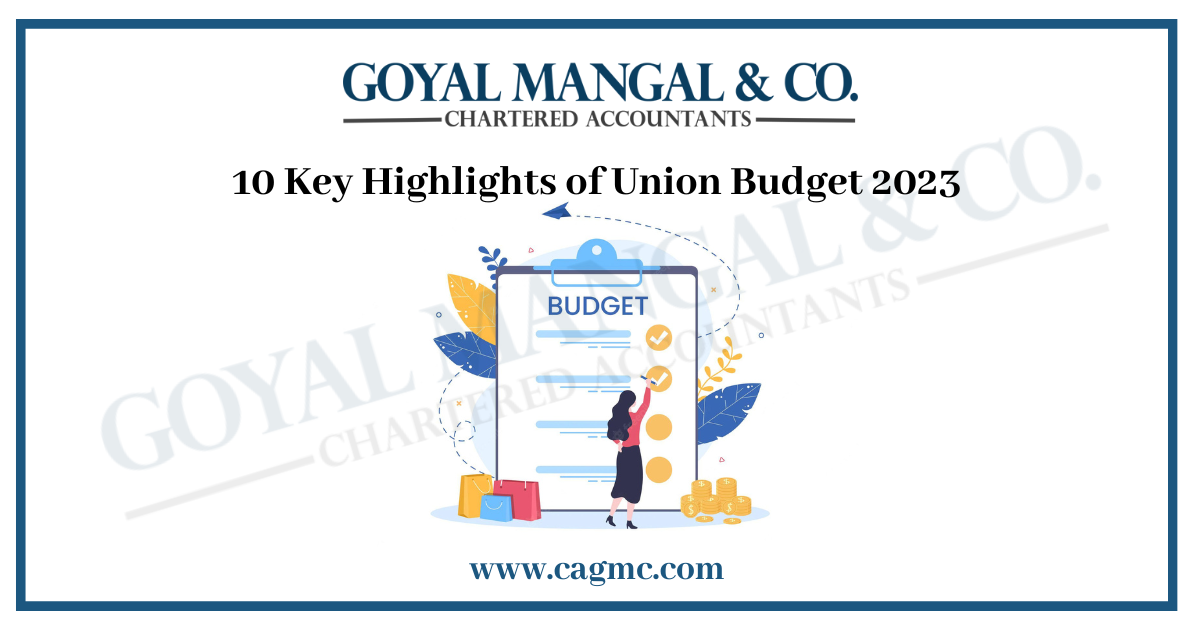
The Union Budget is presented by Finance Minister Nirmala Sitharaman, on 1st February 2023 in the backdrop of rising worldwide inflation and low economic growth. The industry has huge expectations from the approaching budget from an Indirect Tax and Customs perspective towards the development of a friendly tax system and bringing much-needed impetus to economic growth.
The general budget for the financial year 2023 is presented by the Union Finance Minister Nirmala Sitharaman on 1 February 2023, this year it was the fifth consecutive budget by the finance minister. This is the time when the Indian economy is recovering after the Covid-19 pandemic. A massive public spending program for the Indian economy was announced by the finance minister. This article briefly explains the Key Highlights of Union Budget 2023, & Incentives to Promising Business Sectors.
A Short Overview
The Indian government’s yearly budget, which includes information on all expenditures, income predictions, and development targets, is an important document. The Indian Finance Minister presents the budget to Parliament each year, which serves as the foundation for distributing funds for the nation’s economic and social well-being. Every year, the budget provides information about the nation’s current fiscal and economic foundations, as well as goals, actions, and attempts to improve them.
Similarly, the Finance Minister has proposed a Budget this year with substantial features and advantages for taxpayers, farmers, and industrialists, as well as for the overall growth of the country.
For the convenience of our Readers, we have tried to a give a compact yet insightful overview or highlight of Budget 2023.
So without any further delay let us start with the Key Highlight of Budget 2023.
Key Essentials present in the Budget 2023
The following are the key essentials present in the Budget 2023:
General Announcements
The following are the General Announcement in the Budget 2023:
- The old tax regime has not changed.
- The new tax regime will take precedence over all others.
- In the new tax law, there is no tax on income up to ₹7 lakh per year.
- In the new tax regime, the government will raise the maximum income tax rebate from ₹5 lakh to ₹7 lakh.
- The government will lower the maximum surcharge rate from 37% to 25%.
New Tax Regime
The announcement of the 2023 budget brought relief for the middle class with changes in income tax slabs and rebates.
- The new tax system boosted the individual income tax rebate from ₹5 lakhs to 7 lakhs.
- The new tax rates are:
- 0 to ₹3 lakhs – nil;
- ₹3 to 6 lakhs – 5%;
- ₹6 to 9 Lakhs – 10%;
- ₹9 to 12 Lakhs – 15%;
- ₹12 to 15 Lakhs – 20%; and
- Above 15 Lakhs – 30%
- In the new tax system, the government wants to lower the maximum surcharge rate from 37% to 25%.
- The presumptive tax scheme’s upper limit has been raised from ₹50 lakhs to ₹75 lakhs. It used to be possible for professionals with gross revenues of up to ₹50 lakh to immediately present 50% of their gross receipts as taxable income and pay taxes at the appropriate slab rates. Professionals will now have the same choice if their gross receipts are up to ₹75 lakh.
- The limit of ₹3 lakh for tax exemption on leave encashment on the retirement of non-government salaried employees has been raised to ₹25 lakh.
Housing, Administration and Other Facilities
Under following heads, Housing, Administration and other Facilities are included in Budget 2023:
- For FY 2023–2024, the PM Awas Yojana budget has increased by 66% to ₹79,000 crores.
- To switch from manhole to machine hole mode, 100% mechanical desludging of septic tanks and sewers will be permitted in all cities and municipalities.
- For the first time since 2013–14, the Railways have received the largest capital outlay allocation of ₹2.4 lakh crore.
Investment and Personal Finance Proposals
Under following heads, Investment and Personal Finance Proposals are included in Budget 2023:
- This year’s budget also emphasises managing money for both long-term and short-term objectives. Accordingly, it included financial services and goods that facilitate investing, managing money, and saving.
- Mahila Samman Saving Certificate, the women’s new, one-time savings plan with a two-year term and 7.5% interest rate with a partial withdrawal option, will be introduced.
- The investment cap for modest savings programs like Senior Citizen Savings Schemes (SCSS) was raised from ₹15 lakh to ₹30 lakh.
- The government wants to limit capital gains tax deductions for investments in residential real estate to ₹10 crores.
Custom Duties
The provisions regarding Custom Duties in Budget 2023 are as follows:
- The basic customs duty on heat coils would be cut from 20% to 15%, while the basic customs duty on kitchen chimneys would increase from 7.5% to 15%. To encourage value addition in the production of TVs, it has also recommended lowering the basic customs duty on components and TV panels to 2.5%.
- Cigarette taxes increased by 16%.
- Compound rubber now carries a basic import tariff of 25% instead of 10%.
- Basic customs duties on items manufactured from gold bars have increased.
- Government will reduce customs duties on the import of some components, such as camera lenses. It would grant concessions on the import of lithium-ion batteries.
- On items other than textiles and agriculture, there will be a decrease in basic custom duty rates from 21% to 13%.
- The government will lower import taxes on shrimp feed to encourage exports.
Education
The provisions regarding Education in Budget 2023 are as follows:
- To ease the accessibility of high-quality books across platforms and geographies, languages, genres, and reading levels, a national digital library for kids and adolescents will be established. States will be urged to establish physical libraries for them at the ward and panchayat levels and provide the necessary infrastructure to access the National Digital Library’s resources.
- The finance minister announced the opening of 157 new nursing colleges, which would coexist with the 157 medical colleges that have already been operational since 2014. Also promised was the eradication of sickle cell anaemia by 2047.
- To achieve the goal of Make AI in India and Make AI work for India three Centres of Excellence for Artificial Intelligence will be established.
Incentives to Promising Business Sectors
The provisions regarding Incentives to Promising Business Sectors in Budget 2023 are as follows:
- For the fintech industry, the services of the Government Digital Certificate Depository Digi Locker will be expanded. Currently, the DPI only permits people to keep and exchange certificates, such as academic records, driver’s licenses, and PAN cards, giving financial businesses a boost. The Digital Locker growth for the fintech industry will be centred on documentation accessibility.
- In technical institutions, 100 labs will be set up to develop apps employing 5G services. Labs will address, among other things, programmes like smart classrooms, precision farming, intelligent transit systems, and healthcare to realise a new range of options, business models, and job potential.
- For effective justice administration, Phase 3 of the court project would be launched at an investment of ₹7,000 crores.
Ease of Doing Business
The provisions regarding Ease of Doing Business in Budget 2023 are as follows:
- KYC has gotten easy.
- Over 3,400 law provisions have been decriminalised, and over 39,000 compliances have been lowered to make conducting business easier. The PAN will serve as a standard identifier for all digital systems of the designated government entities for the business establishments required to obtain a permanent account number.
- A 33% increase in capital spending, or ₹10 lakh crore, representing 3.3% of GDP
- The amount now available to states for the 50-year, interest-free loan for capital expenditures has been enhanced to ₹1.3 lakh crore, which is 30% higher than what was allotted for 2022–2023.
- The industry will be enticed to invest in research by the creation of a new programme for pharmaceutical research.
MSME Sector
The provisions regarding MSME Sector in Budget 2023 are as follows:
- The updated Credit Guarantee Scheme for MSMEs would go into operation on April 1, 2023, with an injection of ₹9000 crore into the corpus. This will allow for an additional ₹2 lakh crore in collateral-free credit guarantees, which will allow for a 1% reduction in the cost of borrowing.
- Commercial vehicles and tractors used to transport building materials would benefit from PM Awas Yojana’s 64% increase in funding, which brings the total amount allocated to ₹79,000 crores.
- The government will increase the cap on cash deposits and loans made by Primary Agricultural Credit Societies to ₹2 lakh per member.
Agriculture Sector
The provisions regarding Agriculture Sector in Budget 2023 are as follows:
- A major boost for the nation’s aggrotech businesses is the government’s announcement of digital public infrastructure for agriculture, enabling inclusive farmer-centric services important for crop security.
- According to this budget, the Ministry of Petroleum and Natural Gas will invest ₹35,000 crores in capital projects to support the Green Hydrogen Mission’s goals of energy security, net zero aim, and energy transition.
- To encourage states and UTs to promote alternative fertilisers, PM PRANAM – Programme for Restoration, Awareness, Nutrition, and Improvement of Mother Earth will be established.
Conclusion
The budget demonstrates the government’s commitment to sustained economic growth, highlighted by a flurry of announcements, rebates, and reforms targeted at transforming India into a consumption-based economy. However, the savings and social sectors could end up being the biggest losers due to the new tax regime’s proposed adjustments and the old tax regime’s lack of modifications.


